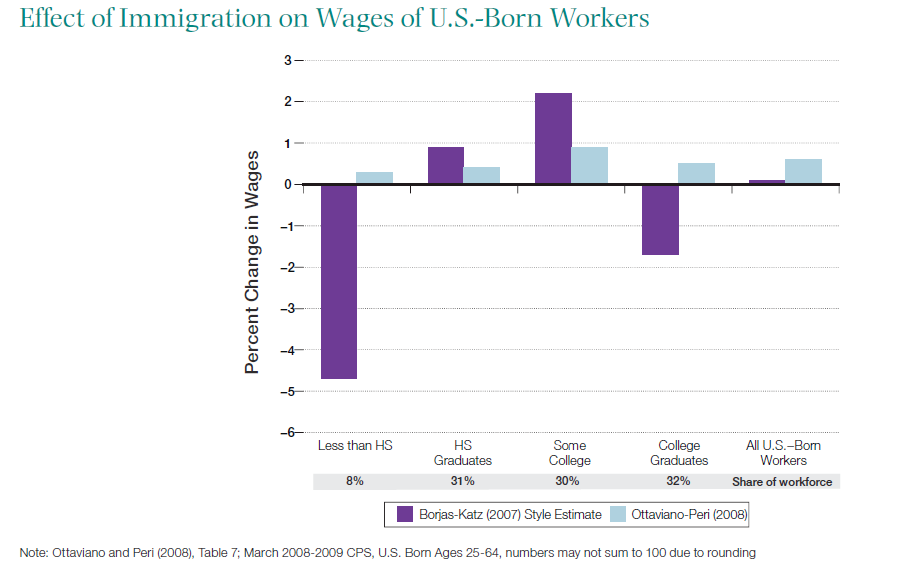With bipartisan momentum mounting for comprehensive immigration reform, cautious optimism has emerged that 2013 will be the year for action. Most Americans agree that our immigration system is flawed, but there remains a lack of understanding about the real effects that new immigrants have on wages, jobs, budgets, and the U.S. economy in general. Two recent Hamilton Project papers provide important economic context for the issue and a potential path forward.
The Project’s “Ten Economic Facts About Immigration” memo explores some of the questions frequently raised around immigration in the United States and provides facts to address many immigration myths. For example, there is concern in some communities that immigrants will replace American workers and reduce our standards of living. On the contrary, the evidence suggests that immigrants typically boost American workers’ overall standard of living by increasing American wages and lowering prices for consumers. Furthermore, the evidence shows that immigrants and U.S.-born workers do not generally compete for the same work. As the chart below illustrates, immigrants create average wage increases of between 0.1 percent and 0.6 percent for American workers. The greatest academic dispute is around the effect on the wages of Americans with less than a high school diploma, with estimates ranging from slightly positive to a decline of 4.7 percent. All in all, immigrants appear to only modestly impact the wages of U.S.-born workers.

There are many different approaches to comprehensive immigration reform, including several fresh ideas being proposed by the President and congressional leaders. One innovative approach that could provide important principles for lawmakers can be found in a Hamilton Project discussion paper, “Rationalizing U.S. Immigration Policy: Reforms for Simplicity, Fairness, and Economic Growth,” by economist Giovanni Peri of UC Davis. In his proposal, Peri offers an incremental, market-based approach to comprehensive reform. Peri proposes starting with market-based changes to employment-based visas to better link visas with labor-market demand.
The proposed system uses market-based auctions to allocate employment-based permits to employers and visas to immigrants that have the greatest propensity to contribute to economic activity and thus to generate the largest benefits for the U.S. economy. These auctions would also generate revenue for the federal government. Policymakers, in turn, could use that revenue for a host of purposes—to tackle the federal deficit, compensate local communities that deliver social services to immigrants, or to invest in the skills of American workers.
How would Peri’s model work? The essential features of the proposal would be implemented in three steps:
- The first step involves a series of incremental phases starting with a pilot program that uses an auction-based system to allocate temporary employment visas.
- After a successful pilot with the existing classes of temporary employment visas, the second phase would expand the auction to permanent labor-sponsored visas.
- A final phase would provide a reassessment of the balance between employment-based and family-based visas, as well as a broad simplification of complicated rules in the current system such as country quotas.
Employers would have the ability to resell or trade permits, and foreign-born workers would have the flexibility to move between permit-holding employers. The added employee flexibility and employer competition provide a strong element of protection for the workers.
The new system would thus eliminate the cumbersome ex-ante labor verification procedures for employers who intend to hire immigrants. This proposal also recommends improvements in immigration enforcement through the use of technology-based enforcement in the workplace and measures to address the current population of undocumented workers.
To read the full proposal, click here. To read the policy brief, click here.
Regardless of the approach, the potential economic benefits of comprehensive immigration reform are great—for American workers and their families, for employers, and for foreign-born workers seeking opportunities in the United States. The key will be to match, at least to some extent, the flow of immigrants with labor market demand, to help ensure the greatest economic boost for all involved. By adding market forces to the equation, immigration reform offers new promise for the American economy—whether through high-skill or agricultural sectors—that we cannot afford to ignore.
Michael Greenstone
is the director of The Hamilton Project and
Adam Looney
is its policy director. For more about the Project, visit
www.hamiltonproject.org
.
The Brookings Institution is committed to quality, independence, and impact.
We are supported by a diverse array of funders. In line with our values and policies, each Brookings publication represents the sole views of its author(s).



Commentary
The Economics of Immigration Reform
January 29, 2013